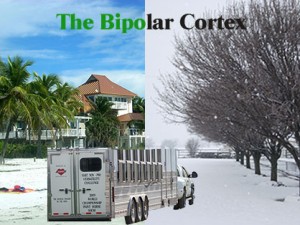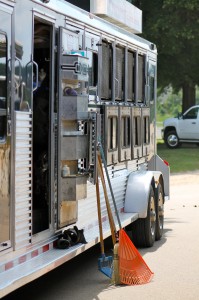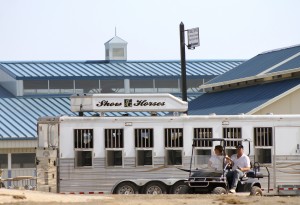The Bipolar Cortex: Concerns When Trailering Horses Through Various Climates
By: Brittany Bevis
Lately, it seems like Mother Nature can’t decide whether she’s ready to spring into warmer weather or if she has a few more weeks of snow and ice on the schedule. While differences in weather conditions vary depending on location in the US, horse show competitors are often faced with the challenge of traveling through various climates on the way to major horse shows during the start of the show season.
For example, when making the trip from somewhere like Sterling, VA, a city currently cloaked in ten inches of snow, to Fort Worth, Texas, where temperatures reached 80 degrees yesterday, there are concerns that arise when considering the comfort, health, and welfare of horses traveling on a horse trailer.
How does the temperature inside a horse trailer differ to the temperature on the outside? What’s better, over blanketing or under blanketing? Does utilizing drop down doors for airflow really change the temperature that much?
To find out the answers to these questions and more we sought out the expertise of Liz Arbittier, a New Bolton Center Field Service veterinarian at the University of Pennsylvania School of Veterinary Medicine.
Q&A with Liz Arbittier
Question 1: To the best of your knowledge, have there been any studies on how the temperature inside a horse trailer differs from the temperature outside the horse trailer? Does the combined body heat of several horses in the trailer make the temperature rise?
Answer 1: “The temperature within a horse trailer containing horses is always higher than outside the trailer, as is the humidity, which is very important,” she says. “More bodies increase the temperature exponentially. Therefore, during hot conditions, it is of utmost importance to have as much ventilation as possible. It is also interesting to note that the interiors of dark-colored horse trailers have been shown to be substantially hotter than reflective or light-colored horse trailers on sunny days.”
Question 2: What’s a good rule of thumb to follow when deciding whether, or how much, to blanket your horse when you plan to travel from a cold to hot climate or vice versa? What concerns should people have about over blanketing a horse to the point that sweating is caused, especially on a long trip when a horse might not drink a lot of water?
Answer 2: “Trailering long distances has been proved repeatedly to be very stressful on many different systems in the horse,” she says. “Thermodynamically, they work quite hard to balance themselves in a moving horse trailer, and that kind of muscular exertion creates heat. In the case of show horses, they are generally clipped, which makes it easier to regulate their temperatures.”
“The most common mistake that people make is over-blanketing in a trailer and creating a sweaty animal, which can be harmful. Long-distance transport has been repeatedly proven to dehydrate horses, so adding to water loss by creating a sweat is dangerous.”
“You can’t expect a horse to make a 12- to 14-hour trip from cold to warm climates and not need to adjust anything. From increasing ventilation to removing a layer, one size does not fit all, and how they fare can depend upon what type of rig they are on and how many other horses are aboard. When adjustments are not able to be made, it is better to err on the side of under-blanketing than over-blanketing, as most people underestimate how much work it is for the horse to be on a trailer for a long duration and how much heat they produce.”
Question 3: When in doubt, is it better to over blanket or under blanket? If you have a six horse trailer, it’s not very practical to stop on the side of the highway to take blankets off as temperatures rise…
Answer 3: “There are plenty of places to stop that don’t involve a highway. Utilize rest stops and other exits to check on, water, and adjust the blanketing of the horses as needed. It is generally fairly easy to find an exit and a parking lot in which to stop and check on the horses. A clipped horse will be easier to manage on this type of trip than a non-clipped horse.”
Question 4: What about utilizing airflow to change temperature with drop down windows or screens?
Answer 4: “Maximizing air flow is one of the most important things a person can do to improve the health of the animal during a trip. Not only will it help cool the horse, it will aid in keeping the air fresh and particulate free.”
“In one study performed to monitor the effects of transport on various stress indices in horses, the amount of particulate matter found in the air at the end of the journey made it unsafe for human exposure. These types of conditions can lead to post-shipping respiratory issues. It is always better to have excellent air flow, even if it means you keep a sheet on the horses as you travel from cold to warm.”
Question 5: Should people utilize an inner trailer thermostat?
Answer 5: “This could be helpful but generally checking the condition of the animal and monitoring each animal individually is information enough to keep them healthy. Different horses will handle conditions differently, depending on their age, health, and body condition.”
When traveling to your next horse show, be sure to keep these helpful tips in mind to ensure the health, safety, and comfort of the horses traveling on your horse trailer.
Author’s Note: This article was developed based on a question received from an EquineChronicle.com reader. We like writing about subjects you find interesting! If you have a suggestion or potential topic for a future web article, contact b.bevis@equinechronicle.com to share your thoughts.













